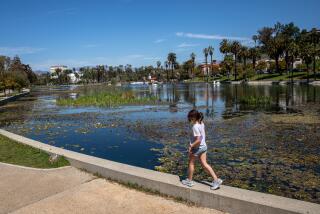High Levels of Toxic Chemical Found : 4 Boatyards Get ’89 Deadline to Reverse Bay Pollution
- Share via
The Regional Water Quality Control Board has ordered four San Diego boatyards to stop polluting their part of San Diego Bay, and has given them until May, 1989, to clean up the contamination, which is not threatening to humans but is toxic to aquatic life.
The boatyards, all situated in the Commercial Basin near Shelter Island, are Kettenburg Marine, Bay City Marine, Shelter Island Boatyard and Mauricio & Sons.
Test results of sediment samples taken in February next to the boatyards found elevated levels of mercury, copper and tributyltin (TBT), chemicals used in boat paint to repel organic growth on ship hulls.
Boatyard owners have been instructed to begin evaluating the damage in the Shelter Island area and have been given until November to submit a report to the water board detailing the projected cleanup costs, said David Barker, a senior water board engineer.
Could Face Penalties
If the boatyards fail to comply with the order, they could face water board-imposed penalties running up to $10,000 a day, he said. But Barker said he doesn’t think that is probable. “We have no reason to believe that they won’t comply,” he said.
Thompson Fetter, president of Kettenburg Marine, which hauls 2,500 boats from the water annually, said his yard has an elaborate system to prevent contamination of the bay. He noted that several owners have operated a boatyard on the site for the past 59 years, and that the contamination may be the result of accumulated residue over those years.
Kettenburg Marine wants to keep the bay clean, Fetter said, and it will cooperate with the authorities.
The level of TBT near the boatyards, for example, is estimated at 6,000 to 9,000 parts per billion, as contrasted with readings of 193 parts per billion found in waters of nearby marinas.
Law Is Not Retroactive
TBT, an extremely toxic chemical, was banned by the state from use in boat paint in January, except on large boats more than 82 feet long. However, the law is not retroactive, thus boat owners aren’t required to strip the paint off their boats.
Barker said the contamination poses no threat to public health but creates unfavorable conditions for such species as clams, snails and abalone, and may eliminate some species altogether.
According to permits issued to the boatyards by the water board, any waste matter, such as paint chips, has to be disposed of on land, including eventually an appropriately designated dump site.
The sediment near the boatyards was the first area to be tested as part of a detailed five-year study of bay water that began last July, Barker said.
Barker said the water board doesn’t know for a fact that the contamination was caused by illegal dumping. Past owners of the yards may also have contributed to the contamination, he said, and the water board will be examining that possibility.
More to Read
Sign up for Essential California
The most important California stories and recommendations in your inbox every morning.
You may occasionally receive promotional content from the Los Angeles Times.










